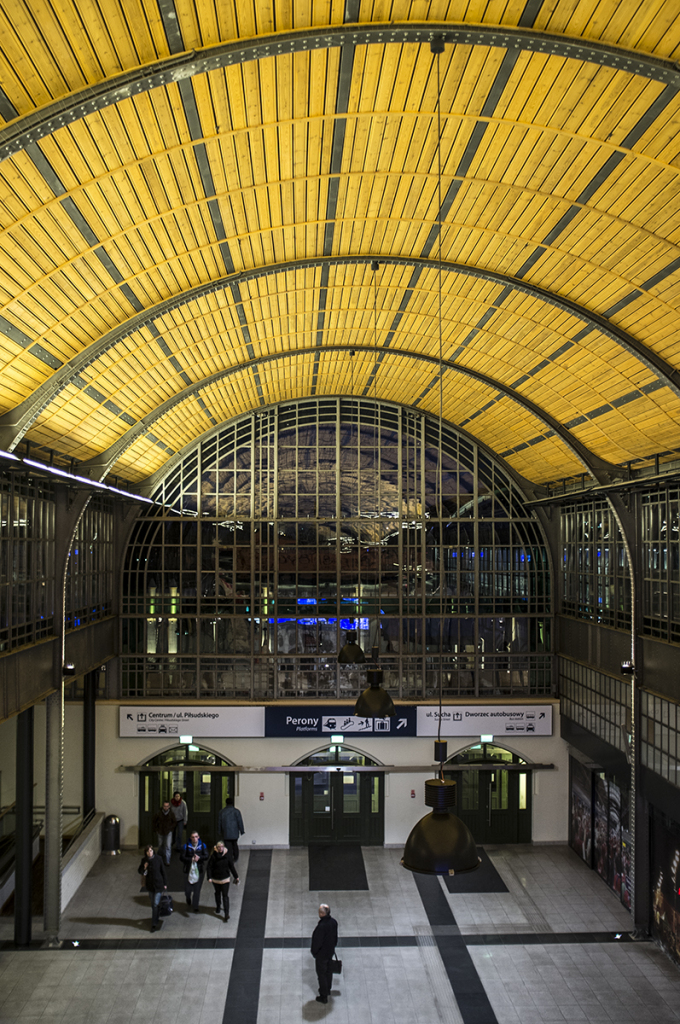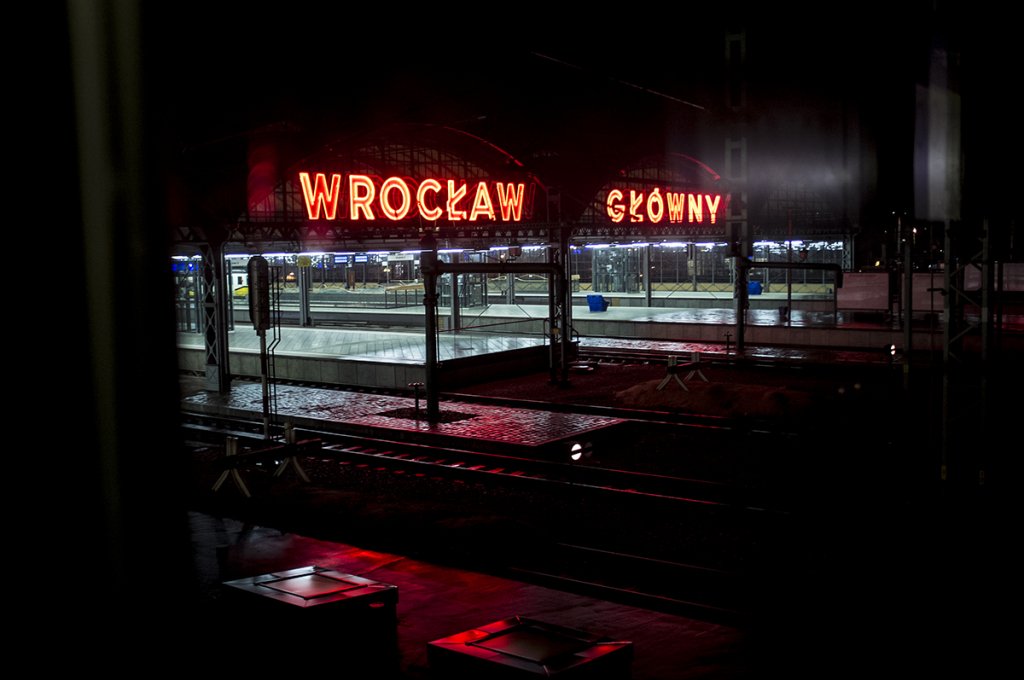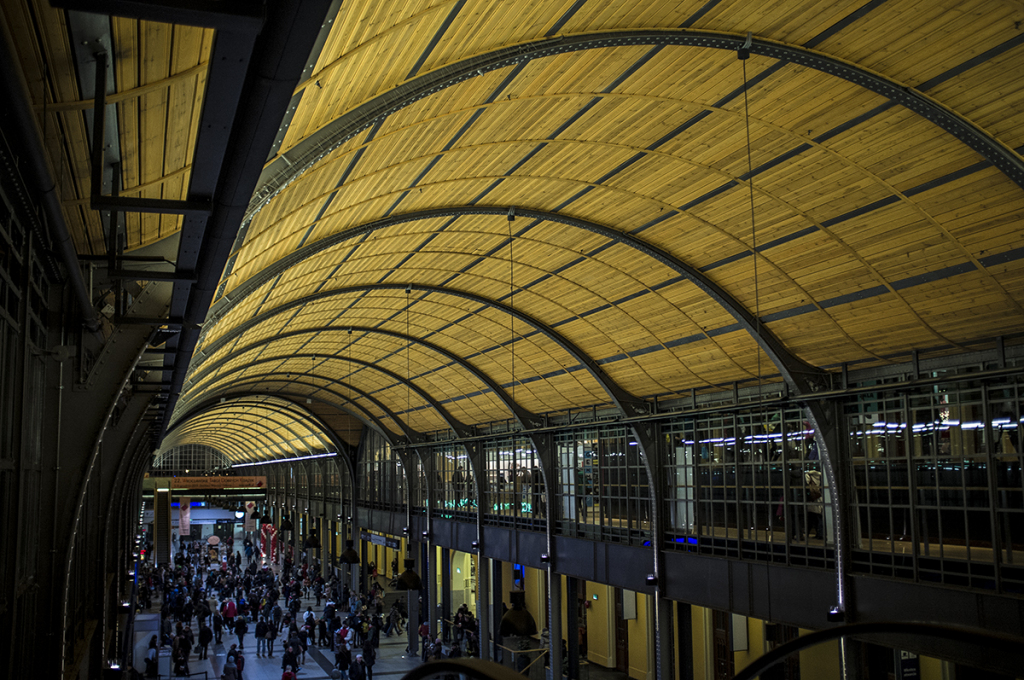Wrocław Główny / Wrocław main station
zdjęcia: Sonia Mielnikiewicz
Jego początki sięgają roku 1853 – wtedy uruchomiono linię Wrocław – Poznań. Niedługo potem wrocławski dworzec stał się największym europejskim dworcem kolejowym. Zachwycał podróżnych wielkością i oryginalnym stylem. Parę lat temu, w wyniku rewitalizacji, odzyskał dawny blask.
Gdy świeci słońce, wrocławski Dworzec Główny wygląda jak z bliskowchodniej baśni –
to za sprawą przywrócenia elewacji oryginalnego koloru o egzotycznie brzmiącej nazwie – ugier. Wybór barwy wynika z badań stratygraficznych i analizy historycznej – dokonano trzystu odkrywek, z których jasno wynika, że dworzec pomalowany był kiedyś na tak intensywny kolor.
Rozbudowa dworca rozpoczęła się w 1855 roku – architekt Wilhelm Grapow miał wizję – jedna z najważniejszych budowli Wrocławia musiała być oryginalna, a w tym czasie zaczynał być modny neogotyk Tudorów. Przy budowie pracowało 250 murarzy, użyto około 425 ton gipsu i 1100 ton cementu. Pierwotnie znajdował się tutaj jeden peron, cztery kasy biletowe, poczta, restauracja, poczekalnie i miejsce wysyłki bagaży. Dwustumetrowa hala (przez którą przebiegało wówczas torowisko) była największą halą dworcową w Europie. Plac przed budynkiem utrzymano w stylu ogrodowym.
Pod koniec XIX wieku, podróże koleją stały się tak popularne, że dworzec trzeba było rozbudować – wybudowano pięć nowych peronów.
W 1943 roku żołnierze Armii Krajowej zorganizowali tutaj zamach bombowy – bomba wybuchła, gdy na peron podjechał pociąg z żołnierzami Wehrmachtu. Zginęły cztery osoby. Rok później pod dworcem zbudowano schron na 500 osób – miał chronić przed bombardowaniami pasażerów i pracowników kolei. Podziemia zostały zalane przez Niemców podczas działań wojennych. Legendy miejskie głoszą, że wybudowano tu szpital, do którego podczas wojny dowożono rannych, a tory kolejowe miały ciągnąć się aż do Berlina.
W styczniu 1967 roku na peronie numer 3 miał miejsce tragiczny wypadek – aktor Zbigniew Cybulski próbując wskoczyć do odjeżdżającego pociągu doznał śmiertelnych obrażeń. Na peronie znajduje się tablica upamiętniająca aktora.
Na wrocławskim dworcu działało ostatnie w Europie kino dworcowe, które zreszta Cybuslki często odwiedzał. Nie posiadało drzwi, można więc było opuścić seans w każdej chwili, tak by zdążyć na pociąg. Filmy wyświetlano non stop systemie dwugodzinnym, a repertuar zmieniał się co tydzień. W ciągu 60 lat filmy obejrzało tutaj ponad 7 milionów widzów. Kino funkcjonowało z przerwami od 1947 roku aż do 2010 – wtedy zamknięto je z powodu rozpoczynającego się remontu generalnego dworca. Dobudowano szósty peron, wyburzono schron a na jego miejscu zbudowano parking podziemny. Dach dworca otrzymał nowe poszycie z drewna, blachy i szkła samoczyszczącego. W styczniu 2011 podczas prac remontowych odkryto tunel z początków XX wieku, którego nie było na żadnych planach.
Its beginnings date back to 1853, when the line Wroclaw – Poznan was launched. It didn’t take long until Wroclaw train station has become the largest in Europe. All travellers were enchanted with its size and original style. A few years ago, after revitalization, it regained its former glory.
When the sun shines, Wroclaw Railway Station looks like Middle East fairy tale – this is because the restoration of the facade gave back the original color of exotic name – ocher.
The colors were chosen according stratigraphic researches and historical analysis – three hundred pits were made, after which it was clear that the station was once painted so intense color.
Expansion of the station began in 1855 – its architect Wilhelm Grapow had a vision that one of the most important buildings in Wroclaw had to be original, and at that time tudor neogothic style began to be fashionable. At the building site was working 200 bricklayers, there was used about 425 tons of gypsum and 1100 tons of cement. Originally there was only one platform, four ticket offices, post office, restaurant, lounges and a place for dispatching bags. Two hundred long hall (through which ran the railway track) was the largest concourse in Europe. The square in front of the building was maintained in the garden style. At the end of the nineteenth century, traveling by trains has become so popular that it was necessary to extend the railway station – five new platforms were built.
In 1943, Home Army soldiers organized bombing here – the bomb exploded, when train with the Wehrmacht soldiers pulled up to the platform. Four people was killed. A year later, under the station was built a shelter for 500 people – intended to protect passengers and railway workers from bombing, but the basement has been flooded by the Germans during the war. Urban legends say that also a hospital was built here, where during the war wounded people were transported, and the railway tracks run all the way to Berlin.
On January 1967, on the platform no. 3 a tragic accident had happened – actor Zbigniew Cybulski, trying to jump into the departing train, suffered some fatal injuries. Now on the platform we can see a plaque commemorating him.
At the station functioned also the last station cinema in Europe, which Cybulski visited quite often. It did not have a door, so you could leave the showing at any time and catch your train. Movies were screened non-stop in two-hours system and the repertoire was changed every week. During 60 years more than 7 million viewers watched movies here. Cinema functioned intermittently since 1947 until 2010 – when it was closed due to the start of the station overhaul. Sixth platform was built, the shelter was demolished and in its place was built an underground parking. The roof of the station received a new canopy of wood, metal and self-cleaning glass. In January 2011, during renovation works was discovered a tunnel from the early twentieth century, which was not in any plans.
Translation: Kasia Wójcik




